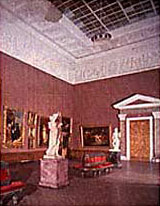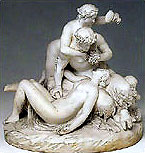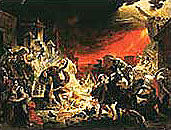 After the Hermitage, the Russian Museum is definitely number two (although this is a bit like comparing Beethoven to Barry Manilow). The museum is located in the former Mikhailovsky Palace (behind the gesticulating Pushkin) in Ploshchad Iskusstv. Built for Paul I's youngest son, the palace was made into a museum in 1898 by Nicholas II.
After the Hermitage, the Russian Museum is definitely number two (although this is a bit like comparing Beethoven to Barry Manilow). The museum is located in the former Mikhailovsky Palace (behind the gesticulating Pushkin) in Ploshchad Iskusstv. Built for Paul I's youngest son, the palace was made into a museum in 1898 by Nicholas II.
The collection of Russian and Soviet art (only the Tretyakov Gallery in Moscow has more) spans medieval icons to grandiose socialist realist paintings. Much of the fun stuff - the early 20th century experimentalists and the mid-century socialist grovelers - is either tucked away in the basement or on tour around the world.
The first floor contains art from the second half of the 19th century to the beginning of the 20th century. One will notice a preponderance of village scenes, landscapes, and portraits of bearded men. Of special note: the works of Alexander Ivanov, whose mystical Christ Appearing to the People (a smaller version of his masterpiece located in the Tretyakov Gallery) in room 21 contrasts with his landscapes and studies of young naked boys in room 22.

Nicholas Ge's pensive and unorthodox Last Supper is in room 26. Eugene Lanseray's bronze Cossack sculptures are in room 27. Savitsky's dynamic To War is in room 31. Ilya Repin, the godfather of Russian realism, is displayed in rooms 33 to 35.
Room 33 has several narrative works (expressing anger in "At The Regional Head Office", exhaustion in "Bargemen on the Volga", and sorrow in "Leave-Taking of a Recruit"). Room 34 has some portraits (there's a great big gnarled and barefoot Tolstoy) and the hysterical historical "Zaporozhye Cossacks Writing a Mocking Letter to the Turkish Sultan". Room 35 displays his landscapes.
Down some stairs from room 35 is a room holding his gargantuan sell-out "Ceremonial Meeting of the State Duma", complete with detailed studies and a table listing who's who in the work.
Older stuff can be found on the second floor (whose rooms look more palace-like than those on the first) thanks to recent renovation. Rooms 1 to 4 hold a large collection of icons dating from the 11th century. Iconographers - monks who painted as a form of spiritual therapy - represented Russian painting exclusively until a slight liberation began under Mikhail Romanov in the 17th century.
This was brought to its conclusion by his grandson, Peter the Great, when he sanctioned the complete secularization of art. Featured items here are the 12th century "Angel Gold-Hair", the last remaining third of a triptych depicting Christ surrounded by angels (room 1);
 Boris and Gleb, depicting the two sons of Grand Duke Vladimir of Kiev who were canonized after having been murdered by their brother (room 1).
Boris and Gleb, depicting the two sons of Grand Duke Vladimir of Kiev who were canonized after having been murdered by their brother (room 1).
There are several works by one of the most famous iconographers of the Moscow School, Andrei Rublev, whose large "Apostle Peter" and "Apostle Paul" were once part of the iconostasis of the Cathedral of the Assumption in Vladimir.
The results of Peter's reforms to Russian art are immediately noticeable in room 5 where portraiture replaces iconography. Among the several portraits of Peter, most notable is Ivan Nikitin's "Peter the Great on his Death Bed". A bronze bust of Peter by Bartolemo Carlo Rastrelli was molded from a plaster mask taken of Peter in 1719. The mask, a cross between Khrushchev and Brando, is also on display.
Speaking of busts, a huge bronze statue of the Empress Anna (called "Anna Ivanovna with an Arab Boy"), also by Rastrelli, is worth a glance in room 7. Room 10 holds art of the time of Catherine the Great, including a life-sized rococo statue of her, portraits, busts of some of her lovers and seven portraits of Catherine's favorite pupils from the Smolny Institute by Dmitry Levitsky.
Rooms 14 and 15, the museum's biggest, hold some of the collection's most famous works: Grigory Ugryumov's "Coronation of Mikhail Romanov" and the "Seizure of Kazan", Ivan Aivazovsky's huge seascapes, and Karl Bryullov's acclaimed "The Last Day of Pompeii".
 The staircase in room 35 leads to the Rossi Wing, which connects the Mikhailovsky Palace with the Benois Wing. Applied art is on display here, part of the Russian Museum's extensive collection of weaving, ceramics, iron work, porcelain, wood carving, lace and intricately carved mammoth tusks. Somehow some matryoshkas and lacquered spoons got in here too, probably due to oversupply at the gift shop.
The staircase in room 35 leads to the Rossi Wing, which connects the Mikhailovsky Palace with the Benois Wing. Applied art is on display here, part of the Russian Museum's extensive collection of weaving, ceramics, iron work, porcelain, wood carving, lace and intricately carved mammoth tusks. Somehow some matryoshkas and lacquered spoons got in here too, probably due to oversupply at the gift shop.
The Benois Wing is named in honor of one of the building's designers, the artist Alexander Benois. Benois was one of the people associated with Mir Iskusstvo, the hip crowd at the beginning of the 20th century, who organized the hottest contemporary art shows in St. Petersburg and Moscow.
The wing is home to the 20th century part of the permanent exhibition (as well as temporary exhibitions that are often more interesting than the entire rest of the museum). At the entrance to the Benois Wing is a statue of Ivan the Terrible as a bent old man grasping his throne with one hand and a bead necklace with the other - rather different than the standard triumphant or fearsome depictions of him.
On the second floor of the Benois Wing you can find tantalizing samples of what's lying stacked in storage rooms or out on a money-making tour of the West - Russian and Soviet art from the end of the 19th and beginning of the 20th century.
 There are works by Vrubel, Kandinsky, the primitivists Natalya Goncharova and Mikhail Larionov, two rooms full of Valentin Serov's portraits, landscapes and historical paintings.
There are works by Vrubel, Kandinsky, the primitivists Natalya Goncharova and Mikhail Larionov, two rooms full of Valentin Serov's portraits, landscapes and historical paintings.
There is a room full of Petrov-Vodkin, and Natan Altman's famous "Portrait of the Poetess Anna Akhmatova", as well as works by other artists from this period. Of the museum's sizeable collection of works by Kazmir Malevich, only a few are ever on display except during special exhibitions. The same goes for the experimental and cerebral works of Pavel Filonov.
The rest of the second floor and the entire first floor of the Benoir Wing are used for special exhibitions. There is an entrance to the Benoir Wing on Kanal Griboyedova just down the street from the Church of the Bleeding Savior.
Behind the museum are the spacious Mikhailovsky Gardens.
Official site of the Russian Museum